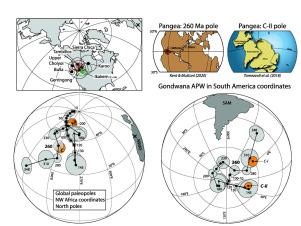Gondwana Research ( IF 7.2 ) Pub Date : 2021-01-13 , DOI: 10.1016/j.gr.2021.01.002 Dennis V. Kent , Paul E. Olsen , Giovanni Muttoni , Mohammed Et-Touhami

|
The nearly 2000 m-thick Ikakern Formation is the basal sedimentary unit in the Argana basin of Morocco, consisting of fluvial red and purple conglomerates in the lower part and interbedded red conglomerates, sandstones, siltstones and mudstones in the upper part. It unconformably overlies deformed and metamorphosed Variscan basement rocks and is unconformably overlain by the finer grained lacustrine to fluvial sediments of the?Early to Late Triassic Timesgadiouine Formation. Vertebrate fossil and chronostratigraphic constraints indicate a post-Kiaman, Late Permian age for at least the sampled upper member (t2) of the Ikakern Formation. A stable, high unblocking temperature dual polarity characteristic magnetization that passes a local fold test gives a paleomagnetic pole for 14 sites at 48.8°N 246.3°E A95 = 7.2° after correction for inclination flattening and indicates a paleolatitude of 14°N for the nominal sampling location at 30.75°N 9.10°W. The Ikakern pole agrees well with poles of similar age deemed reliable in a recent assessment of published data from South America, Africa, Adria, and Australia, which together (N = 7) provide a mean Gondwana pole for an age bin centered on 260 Ma at 52.2°N 239.8°E A95 = 5.0° (NW Africa coordinates). In conjunction with a robust mean 260 Ma pole form Laurasia, these results confirm a Pangea A configuration for the Late Permian. This is in contrast to some recently published interpretations of paleomagnetic data from the Gondwanides of South America that would prolong the existence of a Pangea B configuration from the Late Carboniferous-Early Permian through the Late Permian but which instead probably reflect effects of remagnetization or local rotation.
中文翻译:

Ikakern组(摩洛哥阿尔加纳盆地)的晚二叠纪古极和Pangea的构造
约有2000米厚的Ikakern地层是摩洛哥阿尔加纳盆地的基础沉积单元,由下部的河流红色和紫色砾岩和上部的互层红色砾岩,砂岩,粉砂岩和泥岩组成。它不均匀地覆盖在变形和变质的瓦里斯坎基底岩层上,并且不均匀地被细颗粒的湖相覆盖到早三叠世时代的加迪因岩层的河流沉积物上。脊椎动物的化石和年代地层限制表明至少在Ikakern地层的上半部(t2)上有一个后开曼二叠纪时代。通过局部褶皱测试的稳定,稳定的高温双极性特征磁化强度在48.8°N 246.3°E A95 = 7处产生14个地点的古磁极。校正倾斜度平坦度后为2°,表示在30.75°N 9.10°W处的名义采样位置的古纬度为14°N。在最近对南美,非洲,阿德里亚和澳大利亚的已发布数据进行的评估中,伊卡克伦极点与被认为可靠的类似年龄的极点非常吻合,这些因素合在一起(N = 7)提供一个年龄为260 Ma的年龄段平均冈多瓦纳极点,纬度为52.2°N 239.8°E A95 = 5.0°(西北非洲坐标)。结合稳固的平均260 Ma极月桂形,这些结果证实了晚二叠世的Pangea A构造。这与最近发表的对南美冈德维尼德斯古地磁数据的解释相反,该解释会延长从晚石炭纪-早二叠世一直到晚二叠纪的Pangea B构型的存在,但可能反映了磁化作用或局部旋转的影响。 。











































 京公网安备 11010802027423号
京公网安备 11010802027423号